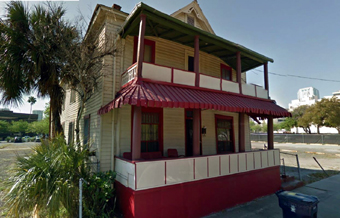
Jackson House: A Place in History
By Earl H. Perkins | Wednesday, January 15, 2014 |
Thursday Review Associate Editor
The Jackson House was a 24-room boarding house built in 1901, but is now the last free-standing residential dwelling in downtown Tampa. The two-story wood-frame structure at 851 Zack St. was one of the only places for blacks to stay when visiting the area during segregation, according to the Tampa Tribune and urban explorer Alex Pickett.
Regular travelers slept there, but then there were the stars—Martin Luther King Jr., Ray Charles, James Brown, Cab Calloway, Ella Fitzgerald, Count Basie, Nat King Cole, Duke Ellington, Chick Webb and the Ink Spots. The Central Avenue neighborhood's heyday was the 1940s, but it flourished for several decades after 1900. There was live music at the Apollo, and many other local bars and nightclubs. Successful doctors, lawyers and entrepreneurs lived in houses throughout the area.
"This was considered to be a five-star rooming house," said Willie Robinson Jr., who inherited the property from his mother, Sarah. There had been a piano in the parlor, and his mother told him Ella Fitzgerald wrote "A-Tisket, A-Tasket" right there, tapping out the keys as she wrote in a notebook. "The most amazing thing about living in history is this hallway. Not because of the stars that stayed here, but I can visualize relatives that I didn't even know."
Then the federal government came calling in the 1950s. Citizens have extolled the virtues of the Eisenhower Interstate Highway System since its inception, but there's always a downside to progress. The feds gutted and bisected tons of black communities throughout the nation, buying the least expensive neighborhoods where the residents possessed little political clout. Eminent domain sounds like such a passive term, until the federal government shows up and takes everything your family ever worked for. Most mom-and-pop stores in this country went under if they weren't located near the newly-constructed interstate highways, or the important secondary roads which fed the interstates.
Anyway, Central Avenue began a slow downhill slide, so those who could began moving out. The drug dealers and addicts moved in, followed closely by the city code inspectors and their wrecking balls. Tampa's urban renewal push in the 1970s wiped out just about everything except the Jackson House, and it received more than its share of demolition threats. Tampa eventually bulldozed the entire black business district.
"How many houses can we point to that are 100 years old and the whole neighborhood around them is completely gone?" said Fred Hearns, Tampa's director of community affairs. "It's a miracle for that house to survive the hazards it could have fallen prey to."
However, Tax Collector Doug Belden, businessman Marvin Knight and Mayor Bob Buckhorn have banded together and the once-grand building could be making a comeback.
"The word is spreading very fast," Belden said. "It's a good community effort."
There was the civil engineer, then landscaping, window repair and air-conditioning businesses came calling, along with local artists, preservationists and other business people. Several fundraising efforts are in the works.
Robinson has been attempting to gain backing for the massive reconstruction effort. After battling for several years, he received local historic landmark designation for the home in 2004. His mother had managed the business for 60 years before passing away in 2006 at 89. The home is now listed on the National Register of Historic Places and Florida's Black Heritage Trail.
For more information, visit Jackson Rooming House.
